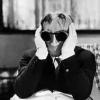
This is a story about a racing driver who in spite of his lack of speed managed to hustle his way
into 7 different Formula 1 teams. A driver who produced some of the worst performances of
modern times in Formula 1 but nevertheless managed to get himself signed by the richest car
manufacturer in world and spearhead their challenge into the toughest motorsport series in the
world.
This is the story of Mika Salo.
In 1994 a new star in the making burst onto the Formula 1 scene. Lotus hired a young Finnish
driver from the Japanese F3000 series to drive in the final two races of the season. This young
charger who's name was Mika Salo had struggled in the Japanese F3000 series for a few years
mostly due to uncompetitive tyres but was moving up the grid when the call came from Lotus.
The press release from Lotus though mentioned his 1991 season in F3 as a deciding factor in
opting for Salo, but the Finn had lost that year's championship by a few points to his countryman
and McLaren driver Mika Hakkinen.
On the 6th of November 1994 Mika Salo took to the grid for the first time in Suzuka Japan. His
experience at the circuit didn't seem to help him much though as he was outqualified by teammate
Alex Zanardi by more than 2 seconds. The race was on the other hand a different story and Salo
displayed a quality which soon proved to be his hallmark in F1. In atrocious conditions Salo
trundled on and finished a respectable 10th without spinning once, never fast but a consistent
finisher.
One week later the F1 circus moved to Adelaide Australia for the final round of the championship.
Mika Salo unfortunately was unable finish the race and after being outqualified by 1.5s by Zanardi
again he retired on lap 41 with a dead battery.
In spite of being in his rookie season Salo's legendary performances in 1994 can at best be called
average, especially at Suzuka. By comparison the same year as Salo made his debut another
driver from the Japanese F3000 series Heinz-Harald Frentzen managed to outqualify a highly rated
and experienced teammate Karl Wendlinger in his first race for Sauber.
Salo joins Tyrrel
For some reason though Mika Salo became a hot property in Formula 1 after these two mediocre
drives.
How much of the interest was due to Finnish Telecom giant Nokia showing signs of entering F1 is
perhaps unknown but with much pomp and circumstance Mika Salo signed for the Nokia - Tyrrel
team.
Roll on the 1995 season and Mika Salo, partnered with Ukyo Katayama, was immediately
outqualified at the first race in Interlagos, Brazil. No worry though as Salo did what he does best
and managed to finish the Grand Prix although two laps down while Katayama spun of early.
For the rest of the season Mika Salo took charge. Regularly outqualifying Katayama and often with
a considerable margin Salo was considered by many to be the next big thing. There was only one
problem, Katayama wasn't very good.
Japanese driver Ukyo Katayama was one of the finds of the 1994 season, especially displaying
very impressive speeds in qualifying. What happened in 1995 was that a F1 regulation was
changed. Until then a driver's weight had not been calculated in the minimum weight of the car,
and Katayama being a very light enjoyed an advantage of more than 0.4 second a lap compared
to his then teammate Mark Blundell. After the regulation change Katayama's pace dropped. So
much in fact that in 1997 he was often outqualified by rookie Jarno Trulli by more than a second.
Katayama probably wasn't helped either by a nasty side to Salo’s character which showed itself
during their seasons together as teammates. Salo having publicly said before the 1996 season
that it was necessary to undermine the confidence of a teammate took every opportunity to
humiliate his weak teammate.
Katayama's birthday cake, given to him by Tyrrel team members, was plastered over his face by
Salo in front the Japanese press and in an interview Salo said that if he for example saw Ukyo with
an ice cream in his hand he would bump into him to get the ice cream onto his face or into his
clothes. Acts that when performed against strong confident drivers like Berger and Senna were
innocent pranks but seemed more sinister when used against a driver who was suffering through
a very bad season.
During the 1995 and 1996 season Mika Salo continued to bask in the sunlight of dominating
Katayama. There was even talk that he would join Schumacher at Ferrari when Ecclestone took
over as the Finns manager for a while. Again though it was thought that main motive for
Ecclestone pressing Salo into the spotlight was not his driving skills but rather his Nokia
connections, it even being rumoured at one point that Nokia might become Formula 1's brand
sponsor.
Stronger teammates
The 1997 and 1998 seasons weren't as successful as the previous seasons for the Finnish driver.
In 1997 when teamed against Schumacher's former teammate Jos Verstappen he encountered
stiffer opposition. The Dutch driver's strong personality ensured that he could not be intimidated
like Salo's former teammate and by the end of the year the two drivers seemed evenly matched.
Although Mika Salo's reputation took a bit of a pounding in 1997 he was still convinced of his own
ability I know I'm better than any of them and signed for the Arrows team in 1998.
The Arrows team looked in 1997 to be a team on the rise. Damon Hill had managed to qualify in
4th place at the last Grand Prix of the season and much was promised for 1998. Salo's teammate
was pay driver Pedro Diniz who had proved himself a good driver on occasion by running Damon
Hill close in several Grand Prix.
Salo was in for a rude shock during that season. Even though more often than not he managed to
outpace Diniz usually there was not much of a performance gap between them. To Arrow's
principal Tom Walkinshaw the difference was that Diniz brought $10 million dollars into the team's
coffers while Salo was paid handsomely.
So in 1999 it seemed like Mika Salo's career as a Formula 1 driver had come to an end. Arrows
desperately needed cash and Salo had proved himself to be very poor value for money. In testing
young and upcoming testdrivers De La Rosa and Takagi proved themselves just as quick so in the
end Salo's contract was not renewed.
In a normal world the book on Mika Salo's F1 career should have been closed, but with the help of
three teams with more money than sense his career was resurrected.
The backup driver
In 1999 perhaps through the influence of his friend Villeneuve, Salo was signed to replace the
injured Ricardo Zonta. Salo's results in the 3 races he drove for BAR were not helped by
considerable problems he had in practice and sometimes qualifying due to unreliability of the car
but that does not excuse how far he was off Villeneuve's pace. It is perhaps astounding that a
driver of Salo's experience could be so slow but the statistics don't lie. At Imola Salo qualified
more than 2 seconds and 14 places! behind his teammate.
Next up was Monaco and there amazingly Salo was only 0.4s and 4 places behind Villeneuve.
Monaco has never one of been Jacques Villeneuve favourite circuits but it is probably Salo's best.
Normality was though restored in his last Grand Prix for BAR when Salo's best lap in qualifying was
only good enough for 16th place while Villeneuve started 10 places and 1 second in front.
Mika Salo's races with BAR were a failure. His qualifying performance was awful and his speed in
the races was not a lot better. The only reason some people could think of why he managed twice
to drag the very unreliable BAR to the finish line was that he drove slowly enough.
For some still unknown reason Mika Salo was hired to replace Michael Schumacher at Ferrari after
Schumacher got sidelined after his accident at Silverstone. Perhaps Ferrari needed a driver that
would bring Ferrari some points but not challenge Irvine, whatever the reason Salo had at the
1999 Austrian GP become a Ferrari driver.
Salo's highlights while driving for Ferrari were without a doubt his podiums at Hockenheim and
Monza. His highly publicized gift to Irvine in Germany resulted many fans screaming for his return
to Ferrari in 2000. Salo though, probably aware of his limitations, said at that point that he'd
better sign a contract for next year before the Hungarian Grand Prix in case he would flop there.
And flop he did.
Mika Salo's drive in the champion contending Ferrari at the Hungaroring in 1999 must be all
accounts rank as the worst performance by an experienced driver in recent times. Without any
reliability problems Salo qualified a massive 2 seconds behind Eddie Irvine. In a car that was in
the hands of Irvine and Schumacher in contention for race wins he qualified one place ahead of a
Minardi and finished the race in 12th having been lapped twice by both the race winner and his
teammate.
Salo's pace at that Grand Prix cannot be blamed on a lack of motivation or poor weather
conditions. He was simply very slow, so slow in fact that he felt the need to apologize for it by
saying that he had let the team down.
Sauber to the rescue
Prior to the Hungarian GP Mika Salo signed a two-year deal with Peter Sauber. He was partnered
with his old teammate Pedro Diniz who brought much needed financing into the Swiss team.
Like at Arrows two years earlier Salo was unable to show that he was much faster than the
Brazilian paydriver. Diniz outqualified him regularly, but as before Salo earned his reputation for
bringing the car home, although slowly.
Near the end of the season it was announced that Salo had signed a 3-year deal with Toyota
thought to be worth $5 million a year. According to some rumours Peter Sauber unimpressed with
his performance had sold Salo's 2001 contract to Toyota for an undisclosed sum while others said
that Salo's contract had included a performance clause which the Swiss team had failed to honour.
The reasons for Toyota opting for Mika Salo were probably that he is considered a good test
driver. Toyota of course needed to build a car from scratch and feedback from an experienced
Formula 1 driver was necessary. What is difficult to understand is that Toyota who is pouring
hundreds of millions of dollars into the F1 program should have chosen Mika Salo as their race
driver as well. What good is if the Toyota engine proves to be 0.2s a lap faster than Honda's?
Villeneuve and Fisichella are driving for Honda and they are much faster than Salo will ever
be. That Toyota with all its resources didn't sign a top Formula 1 driver for their first season
instead of the slow Finn will cost Toyota dearly this season.
And that is my opinon.

























